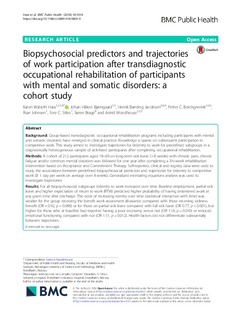| dc.contributor.author | Hara, Karen Walseth | |
| dc.contributor.author | Bjørngaard, Johan Håkon | |
| dc.contributor.author | Jacobsen, Henrik Børsting | |
| dc.contributor.author | Borchgrevink, Petter Chr. | |
| dc.contributor.author | Johnsen, Roar | |
| dc.contributor.author | Stiles, Tore C | |
| dc.contributor.author | Brage, Søren | |
| dc.contributor.author | Woodhouse, Astrid | |
| dc.date.accessioned | 2019-09-03T13:21:55Z | |
| dc.date.available | 2019-09-03T13:21:55Z | |
| dc.date.created | 2018-10-12T11:34:34Z | |
| dc.date.issued | 2018 | |
| dc.identifier.citation | BMC Public Health. 2018, 18:1014 1-17. | nb_NO |
| dc.identifier.issn | 1471-2458 | |
| dc.identifier.uri | http://hdl.handle.net/11250/2612310 | |
| dc.description.abstract | Background
Group-based transdiagnostic occupational rehabilitation programs including participants with mental and somatic disorders have emerged in clinical practice. Knowledge is sparse on subsequent participation in competitive work. This study aimed to investigate trajectories for (re)entry to work for predefined subgroups in a diagnostically heterogeneous sample of sick-listed participants after completing occupational rehabilitation.
Methods
A cohort of 212 participants aged 18–69 on long-term sick leave (> 8 weeks) with chronic pain, chronic fatigue and/or common mental disorders was followed for one year after completing a 3½-week rehabilitation intervention based on Acceptance and Commitment Therapy. Self-reported, clinical and registry data were used to study the associations between predefined biopsychosocial predictors and trajectories for (re)entry to competitive work (≥ 1 day per week on average over 8 weeks). Generalized estimating equations analysis was used to investigate trajectories.
Results
For all biopsychosocial subgroups (re)entry to work increased over time. Baseline employment, partial sick leave and higher expectation of return to work (RTW) predicted higher probability of having (re)entered work at any given time after discharge. The odds of increasing reentry over time (statistical interaction with time) was weaker for the group receiving the benefit work assessment allowance compared with those receiving sickness benefit (OR = 0.92, p = 0.048) or for those on partial sick leave compared with full sick leave (OR 0.77, p < 0.001), but higher for those who at baseline had reported having a poor economy versus not (OR 1.16, p = 0.010) or reduced emotional functioning compared with not (OR 1.11, p = 0.012). Health factors did not differentiate substantially between trajectories.
Conclusions
Work participation after completing a transdiagnostic occupational rehabilitation intervention was investigated. Individual and system factors related to work differentiated trajectories for (re)entry to work, while individual health factors did not. Having a mental disorder did not indicate a worse prognosis for (re)entry to work following the intervention. Future trials within occupational rehabilitation are recommended to pivot their focus to work-related factors, and to lesser extent target diagnostic group. | nb_NO |
| dc.language.iso | eng | nb_NO |
| dc.publisher | BMC (part of Springer Nature) | nb_NO |
| dc.rights | Navngivelse 4.0 Internasjonal | * |
| dc.rights.uri | http://creativecommons.org/licenses/by/4.0/deed.no | * |
| dc.title | Biopsychosocial predictors and trajectories of work participation after transdiagnostic occupational rehabilitation of participants with mental and somatic disorders: A cohort study | nb_NO |
| dc.type | Journal article | nb_NO |
| dc.type | Peer reviewed | nb_NO |
| dc.description.version | publishedVersion | nb_NO |
| dc.source.pagenumber | 1-17 | nb_NO |
| dc.source.volume | 18:1014 | nb_NO |
| dc.source.journal | BMC Public Health | nb_NO |
| dc.identifier.doi | 10.1186/s12889-018-5803-0 | |
| dc.identifier.cristin | 1619954 | |
| dc.description.localcode | © The Author(s). 2018 Open Access This article is distributed under the terms of the Creative Commons Attribution 4.0 International License (http://creativecommons.org/licenses/by/4.0/) | nb_NO |
| cristin.unitcode | 194,65,25,0 | |
| cristin.unitcode | 194,65,20,0 | |
| cristin.unitcode | 1920,28,1,0 | |
| cristin.unitcode | 1920,21,0,0 | |
| cristin.unitcode | 1920,26,0,0 | |
| cristin.unitcode | 1920,5,0,0 | |
| cristin.unitcode | 194,67,40,0 | |
| cristin.unitname | Institutt for sirkulasjon og bildediagnostikk | |
| cristin.unitname | Institutt for samfunnsmedisin og sykepleie | |
| cristin.unitname | Nasjonal kompetansetjeneste for pasienter med sammensatte lidelser | |
| cristin.unitname | PH - Kompetansesenteret for sikkerhets, -fengsels- og rettspsykiatri | |
| cristin.unitname | Sentral stab | |
| cristin.unitname | Klinikk for fysikalsk medisin og rehabilitering | |
| cristin.unitname | Institutt for psykologi | |
| cristin.ispublished | true | |
| cristin.fulltext | original | |
| cristin.qualitycode | 1 | |

